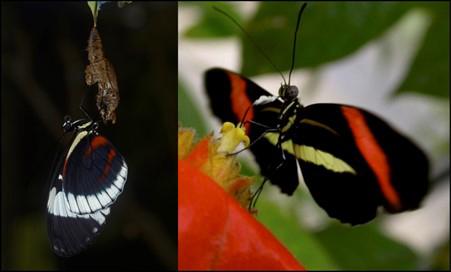
Credit: Rich Merrill
Scientists studying forest dwelling butterflies in Central and South America have discovered that changes in the way animals perceive and process information from their environment can support the emergence of new species. The study led by the University of Bristol, and published today [9 February] in the Proceedings of the National Academy of Sciences (PNAS), has implications for how new species might evolve and the underappreciated role of changes in the brain.
The international team, led by Dr Stephen Montgomery from the School of Biological Sciences at the University of Bristol, compared the brain morphology of two distinct but closely related lineages of butterfly that occur in distinct tropical forest habitats. The first, including the species Heliconius cydno, lives in deeper forests, where the canopy light levels are low. Its sister lineage, including a species called Heliconius melpomene, lives around the forest edges, where light is much more abundant. Despite their ecological differences, these species are very closely related and can still produce viable offspring, suggesting they sit right at the brink of being new species.
The team found substantial differences in the brains of forest edge and deep forest species, with the latter investing more in parts of the brain that process visual information. By collecting butterflies across south and central America, as well as rearing captive individuals under controlled conditions at the Smithsonian Tropical Research Institute in Panama, the researchers showed that differences in brain morphology have accumulated in a way consistent with natural selection.
Dr Stephen Montgomery, Senior Research Fellow at Bristol, said: “These butterflies aren’t separated by huge distances, nor are they distantly related, but their brain structure is finely tuned to the specific habitats they occupy, and we think this process helps keep the two lineages apart, allowing them to become distinct species.”
Similar differences were seen when the team examined the how highly different genes were expressed in the brain.
Matteo Rossi, a PhD student at LMU Munich, explained: “Based on the pattern of gene expression in brain tissue we can accurately cluster individuals into the correct species. The expression of genes driving these differences evolve fast, and seem to be located in regions of the genome that are most distinct between the two species.”
To further explore these effects the team produced hybrid offspring between forest edge and deep forest species. They found these hybrids showed intermediate brain morphologies and patterns of gene expression in the brain.
Dr Richard Merrill, also from LMU Munich, said: “Our study is exciting because it suggests that hybrids in the wild might be behavioural misfits in both habitats, and suffer the consequences.”
The researchers believe that the work may imply adaptations in the brain play an underappreciated role in speciation across environments.
“We’re used to thinking about behaviour being important in speciation, but behavioural evolution must have a neural basis, but we’re only just beginning to unpick this kind of process” added Dr Stephen Montgomery.
The team also hope their work illustrates how important it is to protect habitat complexity in tropical forests.
“The forest is a tapestry of different conditions, with different structures, resources and cues. This work illustrates how closely species evolve to occupy these different micro-habitats, supporting high numbers of species in seemingly small areas” said Dr Owen McMillan, a co-author from the Smithsonian Tropical Research Institute in Panama, “if we want to protect the diversity of species in these areas, we have to protect the forests in a way that supports their natural variability.”
###
The study was funded with support from the Royal Commission for the Great Exhibition of 1851, The Leverhulme Trust, British Ecological Society, the Natural Environment Research Council, the DFG and the Smithsonian Tropical Research Institute.
Media Contact
Joanne Fryer, University of Bristol
[email protected]
Related Journal Article
http://dx.




